Theoretical Studies on the Quantum Capacitance of Two-Dimensional Electrode Materials for Supercapacitors
Abstract
1. Introduction
2. Theoretical Basis
3. Research Progress of 2D Electrode Materials for EDLCs
3.1. Graphene-like 2D Main Group Elements and Compounds
3.1.1. Graphene
3.1.2. Silicene
3.1.3. Germanene
3.1.4. Stanene
3.1.5. Boronene
3.1.6. Phosphorene
3.1.7. Main Group Compounds
3.2. Transition Metal Carbides or Nitrides (MXenes)
3.2.1. Tin+1CnTx
3.2.2. Scn+1CnTx
3.2.3. Hfn+1CnTx
3.2.4. Zrn+1CnTx
3.2.5. Nbn+1AnTx
3.2.6. Mo2C and V2C
3.3. Transition Metal Dichalcogenides (TMDs)
4. Conclusions
Funding
Data Availability Statement
Conflicts of Interest
References
- Huang, Y.; Zhu, M.; Huang, Y.; Pei, Z.; Li, H.; Wang, Z.; Xue, Q.; Zhi, C. Multifunctional Energy Storage and Conversion Devices. Adv. Mater. 2016, 28, 8344–8364. [Google Scholar] [CrossRef]
- Naguib, M.; Mochalin, V.N.; Barsoum, M.W.; Gogotsi, Y. 25th anniversary article: MXenes: A new family of two-dimensional materials. Adv. Mater. 2014, 26, 992–1005. [Google Scholar] [CrossRef]
- Yu, Z.; Tetard, L.; Zhai, L.; Thomas, J. Supercapacitor electrode materials: Nanostructures from 0 to 3 dimensions. Energy Environ. Sci. 2015, 8, 702–730. [Google Scholar] [CrossRef]
- Vangari, M.; Pryor, T.; Jiang, L. Supercapacitors: Review of Materials and Fabrication Methods. J. Energ. Eng. 2013, 139, 72–79. [Google Scholar] [CrossRef]
- Raza, W.; Ali, F.; Raza, N.; Luo, Y.; Kim, K.-H.; Yang, J.; Kumar, S.; Mehmood, A.; Kwon, E.E. Recent advancements in supercapacitor technology. Nano Energy 2018, 52, 441–473. [Google Scholar] [CrossRef]
- Libich, J.; Máca, J.; Vondrák, J.; Čech, O.; Sedlaříková, M. Supercapacitors: Properties and applications. J. Energy Storage 2018, 17, 224–227. [Google Scholar] [CrossRef]
- Yang, W.; Ni, M.; Ren, X.; Tian, Y.; Li, N.; Su, Y.; Zhang, X. Graphene in Supercapacitor Applications. Curr. Opin. Colloid. Interface Sci. 2015, 20, 416–428. [Google Scholar] [CrossRef]
- Najib, S.; Erdem, E. Current progress achieved in novel materials for supercapacitor electrodes: Mini review. Nanoscale Adv. 2019, 1, 2817–2827. [Google Scholar] [CrossRef]
- Yin, X.; Zhang, J.; Yang, L.; Xiao, W.; Zhou, L.; Tang, Y.; Yang, W. Carbon electrodes with ionophobic characteristics in organic electrolyte for high-performance electric double-layer capacitors. Sci. China Chem. 2021, 65, 383–390. [Google Scholar] [CrossRef]
- Schütter, C.; Pohlmann, S.; Balducci, A. Industrial Requirements of Materials for Electrical Double Layer Capacitors: Impact on Current and Future Applications. Adv. Energy Mater. 2019, 9, 00334. [Google Scholar] [CrossRef]
- Zhan, C.; Neal, J.; Wu, J.; Jiang, D.-E. Quantum Effects on the Capacitance of Graphene-Based Electrodes. J. Phys. Chem. C 2015, 119, 22297–22303. [Google Scholar] [CrossRef]
- Paek, E.; Pak, A.J.; Kweon, K.E.; Hwang, G.S. On the Origin of the Enhanced Supercapacitor Performance of Nitrogen-Doped Graphene. J. Phys. Chem. C 2013, 117, 5610–5616. [Google Scholar] [CrossRef]
- Pak, A.J.; Paek, E.; Hwang, G.S. Relative contributions of quantum and double layer capacitance to the supercapacitor performance of carbon nanotubes in an ionic liquid. Phys. Chem. Chem. Phys. 2013, 15, 19741–19747. [Google Scholar] [CrossRef]
- Yang, G.M.; Zhang, H.Z.; Fan, X.F.; Zheng, W.T. Density Functional Theory Calculations for the Quantum Capacitance Performance of Graphene-Based Electrode Material. J. Phys. Chem. C 2015, 119, 6464–6470. [Google Scholar] [CrossRef]
- Paek, E.; Pak, A.J.; Hwang, G.S. Curvature Effects on the Interfacial Capacitance of Carbon Nanotubes in an Ionic Liquid. J. Phys. Chem. C 2013, 117, 23539–23546. [Google Scholar] [CrossRef]
- Paek, E.; Pak, A.J.; Hwang, G.S. A Computational Study of the Interfacial Structure and Capacitance of Graphene in [BMIM][PF6] Ionic Liquid. J. Electrochem. Soc. 2012, 160, A1–A10. [Google Scholar] [CrossRef]
- Yu, G.L.; Jalil, R.; Belle, B.; Mayorov, A.S.; Blake, P.; Schedin, F.; Morozov, S.V.; Ponomarenko, L.A.; Chiappini, F.; Wiedmann, S.; et al. Interaction phenomena in graphene seen through quantum capacitance. Proc. Natl. Acad. Sci. USA 2013, 110, 3282–3286. [Google Scholar] [CrossRef]
- Luryi, S. Quantum capacitance devices. Appl. Phys. Lett. 1988, 52, 501–503. [Google Scholar] [CrossRef]
- John, D.L.; Castro, L.C.; Pulfrey, D.L. Quantum capacitance in nanoscale device modeling. J. Appl. Phys 2004, 96, 5180–5184. [Google Scholar] [CrossRef]
- Zhang, L.; Huang, K.; Wen, P.; Wang, J.; Yang, G.; Liu, D.; Lin, Z.; Lian, C.; Liu, H.; Zheng, S.; et al. Tailoring the defects of two-dimensional borocarbonitride nanomesh for high energy density micro-supercapacitor. Energy Stor. Mater. 2021, 42, 430–437. [Google Scholar] [CrossRef]
- Lu, X.; Wang, C.; Favier, F.; Pinna, N. Electrospun Nanomaterials for Supercapacitor Electrodes: Designed Architectures and Electrochemical Performance. Adv. Energy Mater. 2017, 7, 1601301. [Google Scholar] [CrossRef]
- Poudel, M.B.; Kim, H.J. Confinement of Zn-Mg-Al-layered double hydroxide and α-Fe2O3 nanorods on hollow porous carbon nanofibers: A free-standing electrode for solid-state symmetric supercapacitors. Chem. Eng J. 2022, 429, 132345. [Google Scholar] [CrossRef]
- He, P.; Chen, S. Vertically Oriented Graphene Nanosheets for Electrochemical Energy Storage. ChemElectroChem 2021, 8, 783–797. [Google Scholar] [CrossRef]
- Bokhari, S.W.; Siddique, A.H.; Sherrell, P.C.; Yue, X.; Karumbaiah, K.M.; Wei, S.; Ellis, A.V.; Gao, W. Advances in graphene-based supercapacitor electrodes. Energy Rep. 2020, 6, 2768–2784. [Google Scholar] [CrossRef]
- Frackowiak, E. Carbon materials for supercapacitor application. Phys. Chem. Chem. Phys. 2007, 9, 1774–1785. [Google Scholar] [CrossRef]
- Zhang, L.L.; Zhao, X.S. Carbon-based materials as supercapacitor electrodes. Chem. Soc. Rev. 2009, 38, 252031. [Google Scholar] [CrossRef]
- Borenstein, A.; Hanna, O.; Attias, R.; Luski, S.; Brousse, T.; Aurbach, D. Carbon-based composite materials for supercapacitor electrodes: A review. J. Mater. Chem. A 2017, 5, 12653–12672. [Google Scholar] [CrossRef]
- Hirunsit, P.; Liangruksa, M.; Khanchaitit, P. Electronic structures and quantum capacitance of monolayer and multilayer graphenes influenced by Al, B, N and P doping, and monovacancy: Theoretical study. Carbon 2016, 108, 7–20. [Google Scholar] [CrossRef]
- Kopp, T.; Mannhart, J. Calculation of the capacitances of conductors: Perspectives for the optimization of electronic devices. J. Appl. Phys. 2009, 106, 064504. [Google Scholar] [CrossRef]
- Lin, J.; Yu, T.; Han, F.; Yang, G. Computational predictions of two-dimensional anode materials of metal-ion batteries. Wiley. Interdiscip. Rev. Comput. Mol. Sci. 2020, 10, 147310. [Google Scholar] [CrossRef]
- Malko, D.; Neiss, C.; Vines, F.; Gorling, A. Competition for graphene: Graphynes with direction-dependent Dirac cones. Phys. Rev. Lett. 2012, 108, 086804. [Google Scholar] [CrossRef] [PubMed]
- Tiwari, S.K.; Sahoo, S.; Wang, N.; Huczko, A. Graphene research and their outputs: Status and prospect. J. Sci. Adv. Mater. Devices 2020, 5, 10–29. [Google Scholar] [CrossRef]
- Xia, J.; Chen, F.; Li, J.; Tao, N. Measurement of the quantum capacitance of graphene. Nat. Nanotechnol. 2009, 4, 505–509. [Google Scholar] [CrossRef]
- Jeong, H.M.; Lee, J.W.; Shin, W.H.; Choi, Y.J.; Shin, H.J.; Kang, J.K.; Choi, J.W. Nitrogen-doped graphene for high-performance ultracapacitors and the importance of nitrogen-doped sites at basal planes. Nano Lett. 2011, 11, 2472–2477. [Google Scholar] [CrossRef] [PubMed]
- Kim, W.; Joo, J.B.; Kim, N.; Oh, S.; Kim, P.; Yi, J. Preparation of nitrogen-doped mesoporous carbon nanopipes for the electrochemical double layer capacitor. Carbon 2009, 47, 1407–1411. [Google Scholar] [CrossRef]
- Li, W.; Chen, D.; Li, Z.; Shi, Y.; Wan, Y.; Wang, G.; Jiang, Z.; Zhao, D. Nitrogen-containing carbon spheres with very large uniform mesopores: The superior electrode materials for EDLC in organic electrolyte. Carbon 2007, 45, 1757–1763. [Google Scholar] [CrossRef]
- Seredych, M.; Hulicova-Jurcakova, D.; Lu, G.Q.; Bandosz, T.J. Surface functional groups of carbons and the effects of their chemical character, density and accessibility to ions on electrochemical performance. Carbon 2008, 46, 1475–1488. [Google Scholar] [CrossRef]
- Lota, G.; Frackowiak, E. Pseudocapacitance Effects for Enhancement of Capacitor Performance. Fuel Cells 2010, 10, 848–855. [Google Scholar] [CrossRef]
- Qiu, Y.; Zhang, X.; Yang, S. High performance supercapacitors based on highly conductive nitrogen-doped graphene sheets. Phys. Chem. Chem. Phys. 2011, 13, 125548. [Google Scholar] [CrossRef]
- Paraknowitsch, J.P.; Zhang, J.; Su, D.; Thomas, A.; Antonietti, M. Ionic liquids as precursors for nitrogen-doped graphitic carbon. Adv. Mater. 2010, 22, 87–92. [Google Scholar] [CrossRef]
- Hulicova-Jurcakova, D.; Kodama, M.; Shiraishi, S.; Hatori, H.; Zhu, Z.H.; Lu, G.Q. Nitrogen-Enriched Nonporous Carbon Electrodes with Extraordinary Supercapacitance. Adv. Funct. Mater. 2009, 19, 1800–1809. [Google Scholar] [CrossRef]
- Zhang, L.L.; Zhao, X.; Ji, H.; Stoller, M.D.; Lai, L.; Murali, S.; McDonnell, S.; Cleveger, B.; Wallace, R.M.; Ruoff, R.S. Nitrogen doping of graphene and its effect on quantum capacitance, and a new insight on the enhanced capacitance of N-doped carbon. Energy Environ. Sci. 2012, 5, 9618–9625. [Google Scholar] [CrossRef]
- Mousavi-Khoshdel, S.M.; Targholi, E. Exploring the effect of functionalization of graphene on the quantum capacitance by first principle study. Carbon 2015, 89, 148–160. [Google Scholar] [CrossRef]
- Chen, L.; Li, X.; Ma, C.; Wang, M.; Zhou, J. Interaction and Quantum Capacitance of Nitrogen/Sulfur Co-Doped Graphene: A Theoretical Calculation. J. Phys. Chem. C 2017, 121, 18344–18350. [Google Scholar] [CrossRef]
- Hu, R.; Shang, J. Quantum capacitance of transition metal and nitrogen co-doped graphenes as supercapacitors electrodes: A DFT study. Appl. Surf. Sci. 2019, 496, 143659. [Google Scholar] [CrossRef]
- Wang, M.; Chen, L.; Zhou, J.; Xu, L.; Li, X.; Li, L.; Li, X. First-principles calculation of quantum capacitance of metals doped graphenes and nitrogen/metals co-doped graphenes: Designing strategies for supercapacitor electrodes. J. Mater. Sci. 2018, 54, 483–492. [Google Scholar] [CrossRef]
- Song, C.; Wang, J.; Meng, Z.; Hu, F.; Jian, X. Density Functional Theory Calculations of the Quantum Capacitance of Graphene Oxide as a Supercapacitor Electrode. Chemphyschem 2018, 19, 1579–1583. [Google Scholar] [CrossRef]
- Sruthi, T.; Kartick, T. Route to achieving enhanced quantum capacitance in functionalized graphene based supercapacitor electrodes. J. Phys. Condens. Matter. 2019, 31, 475502. [Google Scholar] [CrossRef]
- Xu, Q.; Yang, G.; Fan, X.; Zheng, W. Improving the Quantum Capacitance of Graphene-Based Supercapacitors by the Doping and Co-Doping: First-Principles Calculations. ACS Omega 2019, 4, 13209–13217. [Google Scholar] [CrossRef]
- Zhang, B.; Peng, Z.; Song, L.; Wu, X.; Fu, X. Computational screening toward quantum capacitance of transition-metals and vacancy doped/co-doped graphene as electrode of supercapacitors. Electrochim. Acta 2021, 385, 138432. [Google Scholar] [CrossRef]
- Sruthi, T.; Tarafder, K. Enhancement of quantum capacitance by chemical modification of graphene supercapacitor electrodes: A study by first principles. Bull. Mater. Sci. 2019, 42, 257–263. [Google Scholar] [CrossRef]
- Cui, G.-Y.; Yi, Z.-L.; Su, F.-Y.; Chen, C.-M.; Han, P.-D. A DFT study of the effect of stacking on the quantum capacitance of bilayer graphene materials. New Carbon Mater. 2021, 36, 1062–1070. [Google Scholar] [CrossRef]
- Zhou, Q.; Ju, W.; Yong, Y.; Zhang, Q.; Liu, Y.; Li, J. Effect of the N/P/S and transition-metal co-doping on the quantum capacitance of supercapacitor electrodes based on mono- and multilayer graphene. Carbon 2020, 170, 368–379. [Google Scholar] [CrossRef]
- Zeng, W.; Zhang, Y.; Liu, X.; Qi, L.; Kang, W.; Fang, L.; Zhou, M. B/N-doped graphdiyne as superior supercapacitor electrode with record high quantum capacitance. Appl. Surf. Sci. 2020, 523, 146468. [Google Scholar] [CrossRef]
- Nawaz, S.; Tahir, M. Quantum capacitance in monolayers of silicene and related buckled materials. Phys. E Low Dimens. Syst. Nanostruct. 2016, 76, 169–172. [Google Scholar] [CrossRef]
- Yang, G.M.; Xu, Q.; Fan, X.; Zheng, W.T. Quantum Capacitance of Silicene-Based Electrodes from First-Principles Calculations. J. Phys. Chem. C 2018, 122, 1903–1912. [Google Scholar] [CrossRef]
- Momeni, M.J.; Mousavi-Khoshdel, M.; Leisegang, T. Exploring the performance of pristine and defective silicene and silicene-like XSi3 (X = Al, B, C, N, P) sheets as supercapacitor electrodes: A density functional theory calculation of quantum capacitance. Phys. E Low Dimens. Syst. Nanostruct. 2020, 124, 114290. [Google Scholar] [CrossRef]
- Xu, Q.; Yang, G.M.; Fan, X.; Zheng, W.T. Adsorption of metal atoms on silicene: Stability and quantum capacitance of silicene-based electrode materials. Phys. Chem. Chem. Phys. 2019, 21, 4276–4285. [Google Scholar] [CrossRef]
- Liu, C.-C.; Jiang, H.; Yao, Y. Low-energy effective Hamiltonian involving spin-orbit coupling in silicene and two-dimensional germanium and tin. Phys. Rev. B 2011, 84, 195430. [Google Scholar] [CrossRef]
- Kaloni, T.P. Tuning the Structural, Electronic, and Magnetic Properties of Germanene by the Adsorption of 3d Transition Metal Atoms. J. Phys. Chem. C 2014, 118, 25200–25208. [Google Scholar] [CrossRef]
- Xu, Q.; Si, X.; She, W.H.; Yang, G.M.; Fan, X.; Zheng, W.T. First-Principles Calculation of Optimizing the Performance of Germanene-Based Supercapacitors by Vacancies and Metal Atoms. J. Phys. Chem. C 2020, 124, 12346–12358. [Google Scholar] [CrossRef]
- Zhang, L.; Bampoulis, P.; Rudenko, A.N.; Yao, Q.; van Houselt, A.; Poelsema, B.; Katsnelson, M.I.; Zandvliet, H.J. Structural and Electronic Properties of Germanene on MoS2. Phys. Rev. Lett. 2016, 116, 256804. [Google Scholar] [CrossRef] [PubMed]
- Liu, N.; Bo, G.; Liu, Y.; Xu, X.; Du, Y.; Dou, S.X. Recent Progress on Germanene and Functionalized Germanene: Preparation, Characterizations, Applications, and Challenges. Small 2019, 15, 1805147. [Google Scholar] [CrossRef]
- Zhuang, J.; Gao, N.; Li, Z.; Xu, X.; Wang, J.; Zhao, J.; Dou, S.X.; Du, Y. Cooperative Electron-Phonon Coupling and Buckled Structure in Germanene on Au(111). ACS Nano 2017, 11, 3553–3559. [Google Scholar] [CrossRef] [PubMed]
- Qin, Z.; Pan, J.; Lu, S.; Shao, Y.; Wang, Y.; Du, S.; Gao, H.J.; Cao, G. Direct Evidence of Dirac Signature in Bilayer Germanene Islands on Cu(111). Adv. Mater. 2017, 29, 1606046. [Google Scholar] [CrossRef] [PubMed]
- Wang, W.; Uhrberg, R.I.G. Investigation of the atomic and electronic structures of highly ordered two-dimensional germanium on Au(111). Phys. Rev. Mater. 2017, 1, 074002. [Google Scholar] [CrossRef]
- Zhuang, J.; Liu, C.; Zhou, Z.; Casillas, G.; Feng, H.; Xu, X.; Wang, J.; Hao, W.; Wang, X.; Dou, S.X.; et al. Dirac Signature in Germanene on Semiconducting Substrate. Adv. Sci. (Weinh) 2018, 5, 180–207. [Google Scholar] [CrossRef]
- Zhou, Q.; Ju, W.; Yong, Y.; Liu, Y.; Li, J. Quantum capacitance of supercapacitor electrodes based on germanene influenced by vacancy and co-doping: A first-principles study. Comput. Mater. Sci. 2021, 188, 110131. [Google Scholar] [CrossRef]
- Si, X.; She, W.; Xu, Q.; Yang, G.; Li, Z.; Wang, S.; Luan, J. First-Principles Density Functional Theory Study of Modified Germanene-Based Electrode Materials. Materials 2021, 15, 103. [Google Scholar] [CrossRef]
- Abbasi, A.; Sardroodi, J.J. The adsorption of sulfur trioxide and ozone molecules on stanene nanosheets investigated by DFT: Applications to gas sensor devices. Phys. E Low Dimens. Syst. Nanostruct. 2019, 108, 382–390. [Google Scholar] [CrossRef]
- Zhang, A.; Yang, H.; Liu, Q.; Li, W.; Wang, Y. DFT insights into the adsorption properties of toxic gas molecules on pure and transition metal embedded stanene monolayers: Towards gas sensor devices. Synth. Met. 2020, 266, 116441. [Google Scholar] [CrossRef]
- Nagarajan, V.; Chandiramouli, R. Adsorption behavior of NH3 and NO2 molecules on stanene and stanane nanosheets—A density functional theory study. Chem. Phys. Lett. 2018, 695, 162–169. [Google Scholar] [CrossRef]
- Sahoo, S.K.; Wei, K.H. A Perspective on Recent Advances in 2D Stanene Nanosheets. Adv. Mater. Interfaces 2019, 6, 00752. [Google Scholar] [CrossRef]
- Shaidu, Y.; Akin-Ojo, O. First principles predictions of superconductivity in doped stanene. Comput. Mater. Sci. 2016, 118, 11–15. [Google Scholar] [CrossRef]
- Evazzade, I.; Roknabadi, M.R.; Morshedloo, T.; Modarresi, M.; Mogulkoc, Y.; Nemati Far, H. Semimetal behavior of bilayer stanene. Phys. E Low Dimens. Syst. Nanostruct. 2017, 89, 155–159. [Google Scholar] [CrossRef]
- Zhou, Q.; Wang, L.; Ju, W.; Yong, Y.; Wu, S.; Cai, S.; Li, P. Quantum capacitance of vacancy-defected and co-doped stanene for supercapacitor electrodes: A theoretical study. Electrochim. Acta 2022, 433, 141261. [Google Scholar] [CrossRef]
- Zhou, Q.; Wang, L.; Ju, W.; Miao, H.; Ye, S.; Liu, Y. Influence of the co-doping and line-doping on the quantum capacitance of stanene for supercapacitor electrodes. Chem. Phys. Lett. 2022, 808, 140123. [Google Scholar] [CrossRef]
- Zhong, H.-X.; Gao, S.; Shi, J.-J.; Yang, L. Quasiparticle band gaps, excitonic effects, and anisotropic optical properties of the monolayer distorted1Tdiamond-chain structuresReS2 andReSe2. Phys. Rev. B 2015, 92, 115438. [Google Scholar] [CrossRef]
- Ramasubramaniam, A. Large excitonic effects in monolayers of molybdenum and tungsten dichalcogenides. Phys. Rev. B 2012, 86, 115409. [Google Scholar] [CrossRef]
- Cheng, T.; Lang, H.; Li, Z.; Liu, Z.; Liu, Z. Anisotropic carrier mobility in two-dimensional materials with tilted Dirac cones: Theory and application. Phys. Chem. Chem. Phys. 2017, 19, 23942–23950. [Google Scholar] [CrossRef]
- Kolavada, H.; Singh, S.; Lukačević, I.; Gajjar, P.N.; Gupta, S.K. Quantum capacitance of multi-layered δ-6 borophene: A DFT study. Electrochim. Acta 2023, 439, 141589. [Google Scholar] [CrossRef]
- Chen, X.; Wang, L.; Wu, Y.; Gao, H.; Wu, Y.; Qin, G.; Wu, Z.; Han, Y.; Xu, S.; Han, T.; et al. Probing the electronic states and impurity effects in black phosphorus vertical heterostructures. 2D Mater. 2016, 3, 015012. [Google Scholar] [CrossRef]
- Chen, X.; Xu, G.; Ren, X.; Li, Z.; Qi, X.; Huang, K.; Zhang, H.; Huang, Z.; Zhong, J. A black/red phosphorus hybrid as an electrode material for high-performance Li-ion batteries and supercapacitors. J. Mater. Chem. A 2017, 5, 6581–6588. [Google Scholar] [CrossRef]
- Batmunkh, M.; Bat-Erdene, M.; Shapter, J.G. Phosphorene and Phosphorene-Based Materials—Prospects for Future Applications. Adv. Mater. 2016, 28, 8586–8617. [Google Scholar] [CrossRef]
- Vishnoi, P.; Rajesh, S.; Manjunatha, S.; Bandyopadhyay, A.; Barua, M.; Pati, S.K.; Rao, C.N.R. Doping Phosphorene with Holes and Electrons through Molecular Charge Transfer. Chemphyschem 2017, 18, 2985–2989. [Google Scholar] [CrossRef]
- Huang, Z.; Wu, Y.; Qi, X.; He, C.; Ren, X.; Zhong, J. Electronic and Magnetic Properties of Monolayer and Bilayer Phosphorene Doped with Transition-Metal Atoms. Phys. Status Solidi. B 2018, 255, 1700370. [Google Scholar] [CrossRef]
- Zu, L.; Gao, X.; Lian, H.; Li, C.; Liang, Q.; Liang, Y.; Cui, X.; Liu, Y.; Wang, X.; Cui, X. Electrochemical prepared phosphorene as a cathode for supercapacitors. J. Alloys Compd. 2019, 770, 26–34. [Google Scholar] [CrossRef]
- Ramesh, A.; Mir, A. Influence of heteroatom doping on the quantum capacitance of phosphorene supercapacitors. J. Energy Storage 2022, 56, 106013. [Google Scholar] [CrossRef]
- Kessler, F.K.; Zheng, Y.; Schwarz, D.; Merschjann, C.; Schnick, W.; Wang, X.; Bojdys, M.J. Functional carbon nitride materials—Design strategies for electrochemical devices. Nat. Rev. Mater. JCR 2017, 2, 17030. [Google Scholar] [CrossRef]
- Zhao, Z.; Sun, Y.; Dong, F. Graphitic carbon nitride based nanocomposites: A review. Nanoscale 2015, 7, 15–37. [Google Scholar] [CrossRef]
- Liu, A.Y.; Wentzcovitch, R.M. Stability of carbon nitride solids. Phys. Rev. B Condens. Matter. 1994, 50, 10362–10365. [Google Scholar] [CrossRef] [PubMed]
- Chen, X.; Xu, W.; Jin, J.; Wang, P.; Song, B.; He, P. Effect of B and O doping on the electronic structure and quantum capacitance of carbon nitride monolayers using first-principles calculations. J. Appl. Phys. 2021, 129, 174301. [Google Scholar] [CrossRef]
- Majdi, A.; Kadhim Wadday, A.; Sabri Abbas, Z.; Kadhim, M.M.; Mahdi Rheima, A.; Barzan, M.; Haitham Alattia, L.; Hachim, S.K.; Abdul Hadi, M. Quantum capacitance of iron metal doped boron carbide monolayer-based for supercapacitors electrodes: A DFT study. Inorg. Chem. Commun. 2023, 150, 110480. [Google Scholar] [CrossRef]
- Naguib, M.; Kurtoglu, M.; Presser, V.; Lu, J.; Niu, J.; Heon, M.; Hultman, L.; Gogotsi, Y.; Barsoum, M.W. Two-dimensional nanocrystals produced by exfoliation of Ti3AlC2. Adv. Mater. 2011, 23, 4248–4253. [Google Scholar] [CrossRef]
- Zhan, X.; Si, C.; Zhou, J.; Sun, Z. MXene and MXene-based composites: Synthesis, properties and environment-related applications. Nanoscale Horiz. 2020, 5, 235–258. [Google Scholar] [CrossRef]
- Shuck, C.E.; Sarycheva, A.; Anayee, M.; Levitt, A.; Zhu, Y.; Uzun, S.; Balitskiy, V.; Zahorodna, V.; Gogotsi, O.; Gogotsi, Y. Scalable Synthesis of Ti3C2Tx MXene. Adv. Eng. Mater. 2020, 22, 01241. [Google Scholar] [CrossRef]
- Li, X.; Wang, C.; Cao, Y.; Wang, G. Functional MXene Materials: Progress of Their Applications. Chem. Asian J. 2018, 13, 2742–2757. [Google Scholar] [CrossRef]
- Hu, T.; Yang, J.; Wang, X. Carbon vacancies in Ti2CT2 MXenes: Defects or a new opportunity? Phys. Chem. Chem. Phys. 2017, 19, 31773–31780. [Google Scholar] [CrossRef]
- Cheng, Y.-W.; Dai, J.-H.; Zhang, Y.-M.; Song, Y. Transition metal modification and carbon vacancy promoted Cr2CO2(MXenes): A new opportunity for a highly active catalyst for the hydrogen evolution reaction. J. Mater. Chem. A 2018, 6, 20956–20965. [Google Scholar] [CrossRef]
- Er, D.; Li, J.; Naguib, M.; Gogotsi, Y.; Shenoy, V.B. Ti3C2 MXene as a high capacity electrode material for metal (Li, Na, K, Ca) lon batteries. ACS Appl. Mater. Interfaces 2014, 6, 11173–11179. [Google Scholar] [CrossRef]
- Lipatov, A.; Alhabeb, M.; Lukatskaya, M.R.; Boson, A.; Gogotsi, Y.; Sinitskii, A. Effect of Synthesis on Quality, Electronic Properties and Environmental Stability of Individual Monolayer Ti3C2MXene Flakes. Adv. Electron. Mater. 2016, 2, 1600255. [Google Scholar] [CrossRef]
- Si, X.; Xu, Q.; Lin, J.; Yang, G. Quantum capacitance modulation of MXenes by metal atoms adsorption. Appl. Surf. Sci. 2023, 618, 156586. [Google Scholar] [CrossRef]
- Bafekry, A.; Nguyen, C.V.; Stampfl, C.; Akgenc, B.; Ghergherehchi, M. Oxygen Vacancies in the Single Layer of Ti2CO2 MXene: Effects of Gating Voltage, Mechanical Strain, and Atomic Impurities. Phys. Status Solidi B 2020, 257, 2000343. [Google Scholar] [CrossRef]
- Su, X.; Guo, R.-G.; Xu, S.; Wang, S.-J.; Li, X.-H.; Cui, H.-L. Influence of O-vacancy concentration on the structural, electronic properties and quantum capacitance of monolayer Ti2CO2: A first-principles study. Vacuum 2022, 196, 110740. [Google Scholar] [CrossRef]
- Li, X.-H.; Liu, M.-Z.; Tan, X.-M.; Su, X.; Guo, R.-G.; Zhang, R.-Z.; Cui, H.-L. Influence of C-vacancy-line defect on electronic and optical properties and quantum capacitance of Ti2CO2 MXene: A first-principles study. J. Phys. Chem. Solids 2023, 176, 111254. [Google Scholar] [CrossRef]
- Li, X.-H.; Li, S.-S.; Cui, X.-H.; Zhang, R.-Z.; Cui, H.-L. First-principle study of electronic properties and quantum capacitance of lithium adsorption on pristine and vacancy-defected O-functionalized Ti2C MXene. Appl. Surf. Sci. 2021, 563, 150264. [Google Scholar] [CrossRef]
- Kumar, S.; Schwingenschlögl, U. Thermoelectric performance of functionalized Sc2C MXenes. Phys. Rev. B 2016, 94, 035405. [Google Scholar] [CrossRef]
- Ma, Z.; Hu, Z.; Zhao, X.; Tang, Q.; Wu, D.; Zhou, Z.; Zhang, L. Tunable Band Structures of Heterostructured Bilayers with Transition-Metal Dichalcogenide and MXene Monolayer. J. Phys. Chem. C 2014, 118, 5593–5599. [Google Scholar] [CrossRef]
- Cui, X.-H.; Li, X.-H.; Jin, X.-J.; Zhang, R.-Z.; Cui, H.-L.; Yan, H.-T. First-principles study on the effect of atomic swap on the electronic properties and quantum capacitance of Sc2CF2 monolayer. Vacuum 2022, 204, 111371. [Google Scholar] [CrossRef]
- Cui, X.-H.; Li, X.-H.; Zhang, R.-Z.; Cui, H.-L.; Yan, H.-T. Theoretical insight into the electronic, optical, and photocatalytic properties and quantum capacitance of Sc2CT2 (T = F, P, Cl, Se, Br, O, Si, S, OH) MXenes. Vacuum 2023, 207, 111615. [Google Scholar] [CrossRef]
- Cui, X.-H.; Li, X.-H.; Li, S.-S.; Cui, H.-L. The effect of vacancy defect on quantum capacitance, electronic and magnetic properties of Sc2CF2 monolayer. Int. J. Quantum Chem. 2021, 121, e26666. [Google Scholar] [CrossRef]
- Zhang, R.-Z.; Cui, X.-H.; Li, S.-S.; Li, X.-H.; Cui, H.-L. DFT computation of quantum capacitance of transition-metals and vacancy doped Sc2CF2 MXene for supercapacitor applications. J. Mol. Liq. 2022, 345, 118263. [Google Scholar] [CrossRef]
- Cui, X.-H.; Li, X.-H.; Zhang, R.-Z.; Cui, H.-L.; Yan, H.-T. Computational study of intrinsic defects on the electronic properties and quantum capacitance of Sc2CF2 monolayer. Surf. Interfaces 2022, 33, 102193. [Google Scholar] [CrossRef]
- Zha, X.H.; Huang, Q.; He, J.; He, H.; Zhai, J.; Francisco, J.S.; Du, S. The thermal and electrical properties of the promising semiconductor MXene Hf2CO2. Sci. Rep. 2016, 6, 27971. [Google Scholar] [CrossRef] [PubMed]
- Wang, Y.; Ma, S.; Wang, L.; Jiao, Z. A novel highly selective and sensitive NH3 gas sensor based on monolayer Hf2CO2. Appl. Surf. Sci. 2019, 492, 116–124. [Google Scholar] [CrossRef]
- Liu, M.-Z.; Li, X.-H.; Cui, X.-H.; Yan, H.-T.; Zhang, R.-Z.; Cui, H.-L. The influence of different functional groups on quantum capacitance, electronic and optical properties of Hf2C MXene. Appl. Surf. Sci. 2022, 605, 154830. [Google Scholar] [CrossRef]
- Lei, J.-C.; Zhang, X.; Zhou, Z. Recent advances in MXene: Preparation, properties, and applications. Front. Phys. 2015, 10, 276–286. [Google Scholar] [CrossRef]
- Liu, M.-Z.; Li, X.-H.; Yan, H.-T.; Zhang, R.-Z.; Cui, H.-L. Influence of N-doped concentration on the electronic properties and quantum capacitance of Hf2CO2 MXene. Vacuum 2023, 210, 111826. [Google Scholar] [CrossRef]
- Cui, X.-H.; Li, X.-H.; Jin, X.-J.; Yan, H.-T.; Zhang, R.-Z.; Cui, H.-L. Biaxial strain tunable quantum capacitance and photocatalytic properties of Hf2CO2 monolayer. Appl. Surf. Sci. 2023, 616, 156579. [Google Scholar] [CrossRef]
- Li, S.-S.; Li, X.-H.; Cui, X.-H.; Zhang, R.-Z.; Cui, H.-L. Effect of the biaxial strain on the electronic structure, quantum capacitance of NH3 adsorption on pristine Hf2CO2 MXene using first-principles calculations. Appl. Surf. Sci. 2022, 575, 151659. [Google Scholar] [CrossRef]
- Li, X.-H.; Cui, X.-H.; Xing, C.-H.; Cui, H.-L.; Zhang, R.-Z. Strain-tunable electronic and optical properties of Zr2CO2 MXene and MoSe2 van der Waals heterojunction: A first principles calculation. Appl. Surf. Sci. 2021, 548, 149249. [Google Scholar] [CrossRef]
- Mostafaei, A.; Faizabadi, E.; Semiromi, E.H. Theoretical studies and tuning the electronic and optical properties of Zr2CO2 monolayer using biaxial strain effect: Modified Becke–Johnson calculation. Physica. E Low Dimens. Syst. Nanostruct. 2019, 114, 113559. [Google Scholar] [CrossRef]
- Xu, S.; Wang, S.J.; Sun, W.Q.; Li, X.H.; Cui, H.L. Density functional theory study of the electronic properties and quantum capacitance of pure and doped Zr2CO2 as electrode of supercapacitors. Int. J. Quantum. Chem. 2021, 122, e26844. [Google Scholar] [CrossRef]
- Li, X.-H.; Jia, H.-Y.; Li, S.-S.; Cui, H.-L. Effect of atomic vacancy on the electronic and optical properties, quantum capacitance of Zr2CO2-based electrodes. Vacuum 2021, 190, 110284. [Google Scholar] [CrossRef]
- Yin, S.H.; Cui, X.H.; Li, X.H.; Wang, S.J.; Zhang, R.Z.; Cui, H.L.; Yan, H.T. Theoretical study on the electronic properties and quantum capacitance of Zr2CO2 MXene with atomic swap. Int. J. Quantum. Chem. 2023, 125, e27135. [Google Scholar] [CrossRef]
- Bai, L.; Yin, H.; Wu, L.; Zhang, X. First-principle study of the Nbn+1CnT2 systems as electrode materials for supercapacitors. Comput. Mater. Sci. 2018, 143, 225–231. [Google Scholar] [CrossRef]
- Xin, Y.; Yu, Y.-X. Possibility of bare and functionalized niobium carbide MXenes for electrode materials of supercapacitors and field emitters. Mater. Des. 2017, 130, 512–520. [Google Scholar] [CrossRef]
- Bharti; Ahmed, G.; Kumar, Y.; Bocchetta, P.; Sharma, S. Determination of Quantum Capacitance of Niobium Nitrides Nb2N and Nb4N3 for Supercapacitor Applications. J. Compos. Sci. 2021, 5, 85. [Google Scholar] [CrossRef]
- Hussain, S.; Rabani, I.; Vikraman, D.; Feroze, A.; Ali, M.; Seo, Y.-S.; Song, W.; An, K.-S.; Kim, H.-S.; Chun, S.-H.; et al. MoS2@X2C (X = Mo or W) hybrids for enhanced supercapacitor and hydrogen evolution performances. Chem. Eng. J. 2021, 421, 127843. [Google Scholar] [CrossRef]
- Hussain, S.; Faizan, M.; Vikraman, D.; Rabani, I.; Ali, B.; Kim, H.-S.; Jung, J.; Nam, K.-W. Eutectoid WXC embedded WS2 nanosheets as a hybrid composite anode for lithium-ion batteries. Ceram. Int. 2021, 47, 18646–18655. [Google Scholar] [CrossRef]
- Poudel, M.B.; Logeshwaran, N.; Kim, A.R.; Karthikeyan, S.C.; Vijayapradeep, S.; Yoo, D.J. Integrated core-shell assembly of Ni3S2 nanowires and CoMoP nanosheets as highly efficient bifunctional electrocatalysts for overall water splitting. J. Alloys Compd. 2023, 960, 170678. [Google Scholar] [CrossRef]
- Lu, C.; Zhang, Y.-S.; Hu, Y.-X.; Li, J.; Zhang, B.-M.; Liu, M.-C. Ultrafine Mo2C nanoparticles supported on three-dimensional hierarchical porous carbon architecture toward electrochemical energy storage applications. J. Energy Storage 2021, 33, 101855. [Google Scholar] [CrossRef]
- Dall’Agnese, Y.; Taberna, P.L.; Gogotsi, Y.; Simon, P. Two-Dimensional Vanadium Carbide (MXene) as Positive Electrode for Sodium-Ion Capacitors. J. Phys. Chem. Lett. 2015, 6, 2305–2309. [Google Scholar] [CrossRef]
- Ai, W.; Zhang, C.; Xia, L.; Miao, H.; Yuan, J. Synthesis of High-Quality Two-Dimensional V2C MXene for Supercapacitor Application. Energies 2022, 15, 3696. [Google Scholar] [CrossRef]
- Bharti; Kumar, Y.; Gupta, M.; Sharma, S. Study of pristine and functionalized V2C and Mo2C MXenes as novel electrode material for supercapacitors. J. Mol. Graph. Model. 2023, 118, 108366. [Google Scholar] [CrossRef]
- Karade, S.S.; Dwivedi, P.; Majumder, S.; Pandit, B.; Sankapal, B.R. First report on a FeS-based 2 V operating flexible solid-state symmetric supercapacitor device. Sustain. Energy Fuels 2017, 1, 1366–1375. [Google Scholar] [CrossRef]
- Yu, F.; Chang, Z.; Yuan, X.; Wang, F.; Zhu, Y.; Fu, L.; Chen, Y.; Wang, H.; Wu, Y.; Li, W. Ultrathin NiCo2S4@graphene with a core–shell structure as a high performance positive electrode for hybrid supercapacitors. J. Mater. Chem. A 2018, 6, 5856–5861. [Google Scholar] [CrossRef]
- Rui, X.; Tan, H.; Yan, Q. Nanostructured metal sulfides for energy storage. Nanoscale 2014, 6, 9889–9924. [Google Scholar] [CrossRef] [PubMed]
- Septianto, R.D.; Liu, L.; Iskandar, F.; Matsushita, N.; Iwasa, Y.; Bisri, S.Z. On-demand tuning of charge accumulation and carrier mobility in quantum dot solids for electron transport and energy storage devices. NPG Asia Mater. 2020, 12, 2–14. [Google Scholar] [CrossRef]
- Lin, Y.C.; Dumcenco, D.O.; Huang, Y.S.; Suenaga, K. Atomic mechanism of the semiconducting-to-metallic phase transition in single-layered MoS2. Nat. Nanotechnol. 2014, 9, 391–396. [Google Scholar] [CrossRef]
- Ali, B.A.; Metwalli, O.I.; Khalil, A.S.G.; Allam, N.K. Unveiling the Effect of the Structure of Carbon Material on the Charge Storage Mechanism in MoS2-Based Supercapacitors. ACS Omega 2018, 3, 16301–16308. [Google Scholar] [CrossRef] [PubMed]
- Yin, X.; Wang, Q.; Cao, L.; Tang, C.S.; Luo, X.; Zheng, Y.; Wong, L.M.; Wang, S.J.; Quek, S.Y.; Zhang, W.; et al. Tunable inverted gap in monolayer quasi-metallic MoS2 induced by strong charge-lattice coupling. Nat. Commun. 2017, 8, 006402. [Google Scholar] [CrossRef] [PubMed]
- Singh, N.; Schwingenschlogl, U. A Route to Permanent Valley Polarization in Monolayer MoS2. Adv. Mater. 2017, 29, 1600970. [Google Scholar] [CrossRef] [PubMed]
- Nie, Z.; Long, R.; Teguh, J.S.; Huang, C.-C.; Hewak, D.W.; Yeow, E.K.L.; Shen, Z.; Prezhdo, O.V.; Loh, Z.-H. Ultrafast Electron and Hole Relaxation Pathways in Few-Layer MoS2. J. Phys. Chem. C 2015, 119, 20698–20708. [Google Scholar] [CrossRef]
- Xu, Q.; Yang, G.M.; Zheng, W.T. DFT calculation for stability and quantum capacitance of MoS2 monolayer-based electrode materials. Mater. Today Commun. 2020, 22, 100772. [Google Scholar] [CrossRef]
- Biby, A.H.; Ali, B.A.; Allam, N.K. Interplay of quantum capacitance with Van der Waals forces, intercalation, co-intercalation, and the number of MoS2 layers. Mater. Today Energy 2021, 20, 100677. [Google Scholar] [CrossRef]
- Irham, M.A.; Muttaqien, F.; Bisri, S.Z.; Iskandar, F. Enhancing quantum capacitance of iron sulfide supercapacitor through defect-engineering: A first-principles calculation. Electrochim. Acta 2023, 449, 142235. [Google Scholar] [CrossRef]

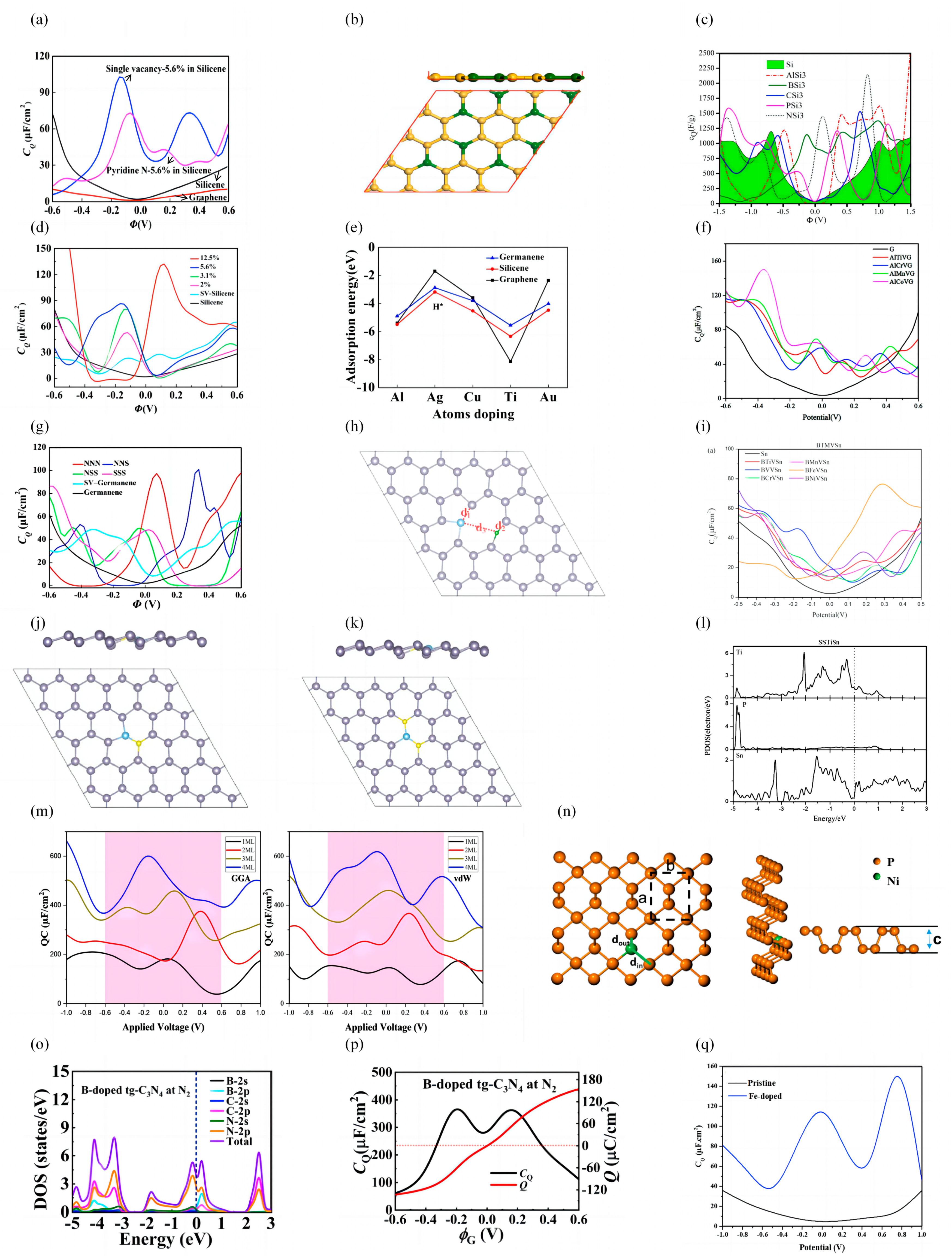
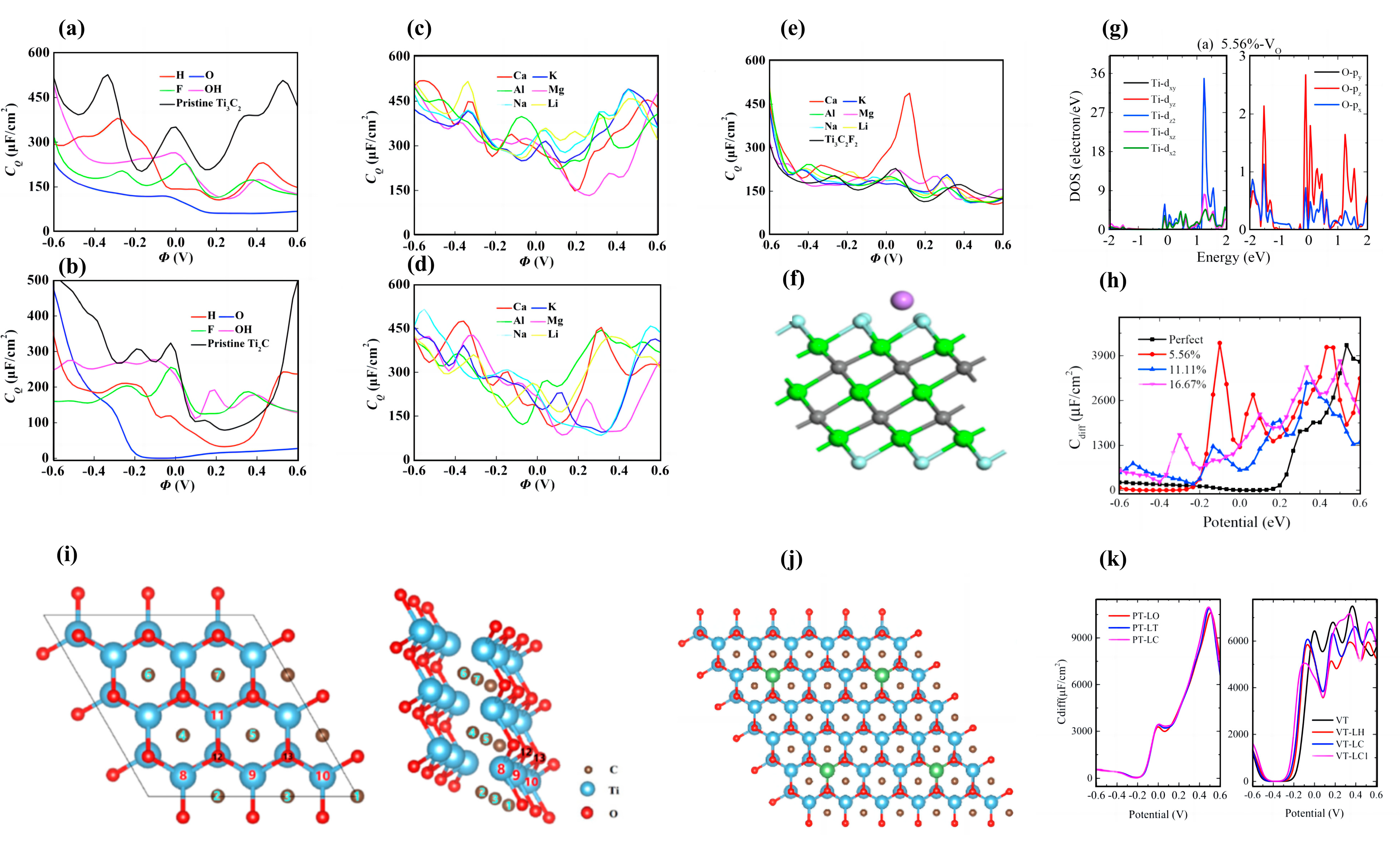
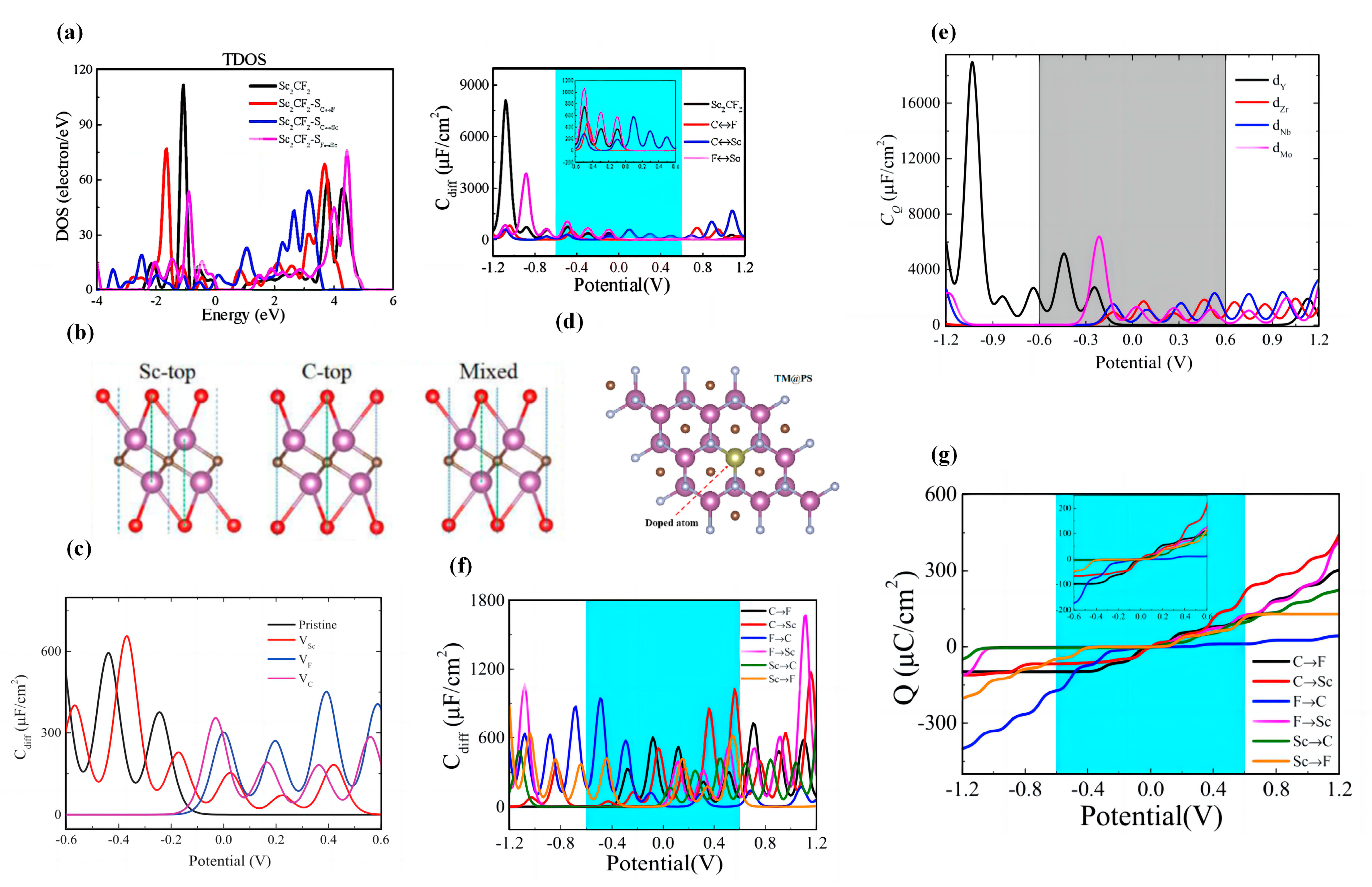
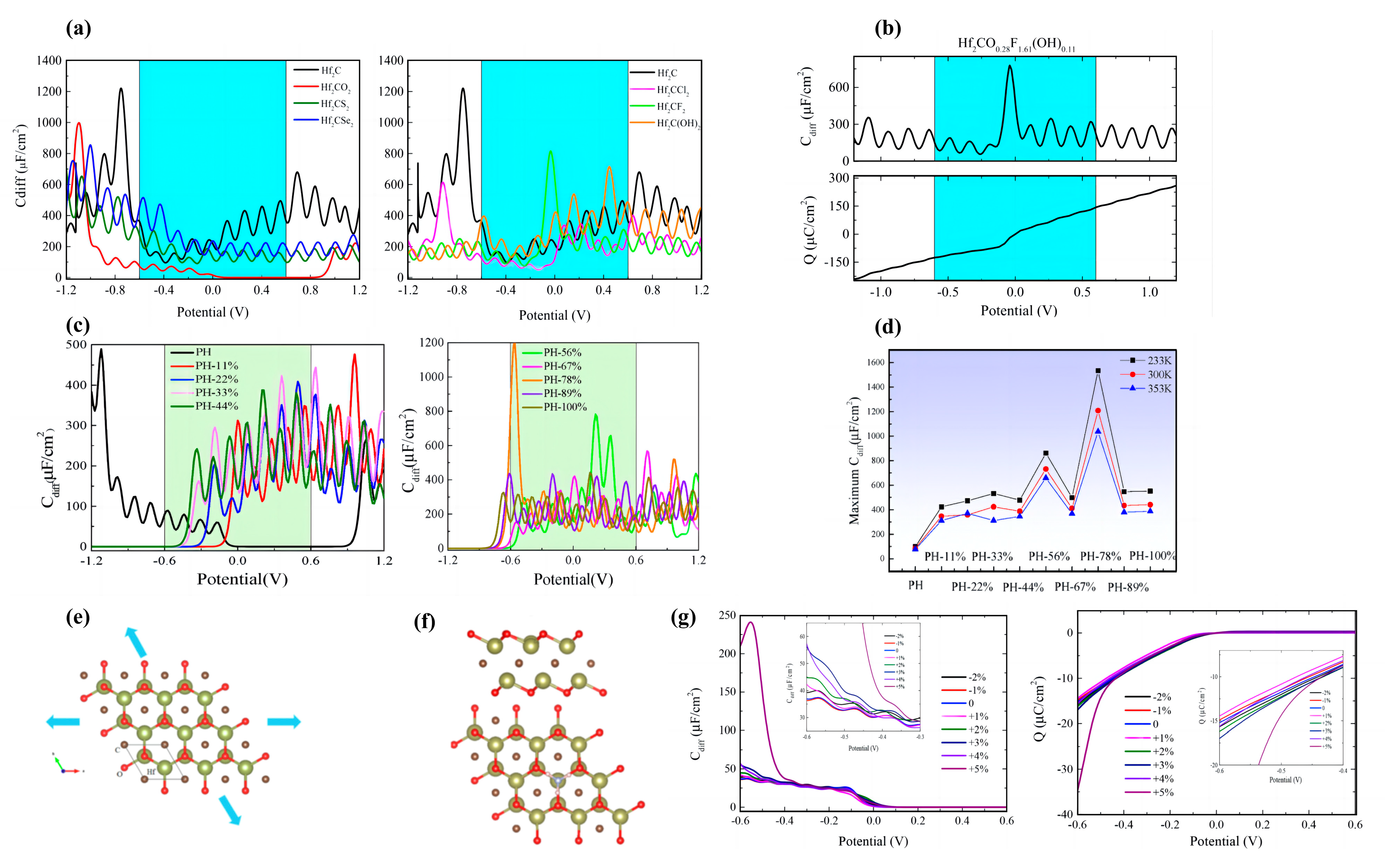

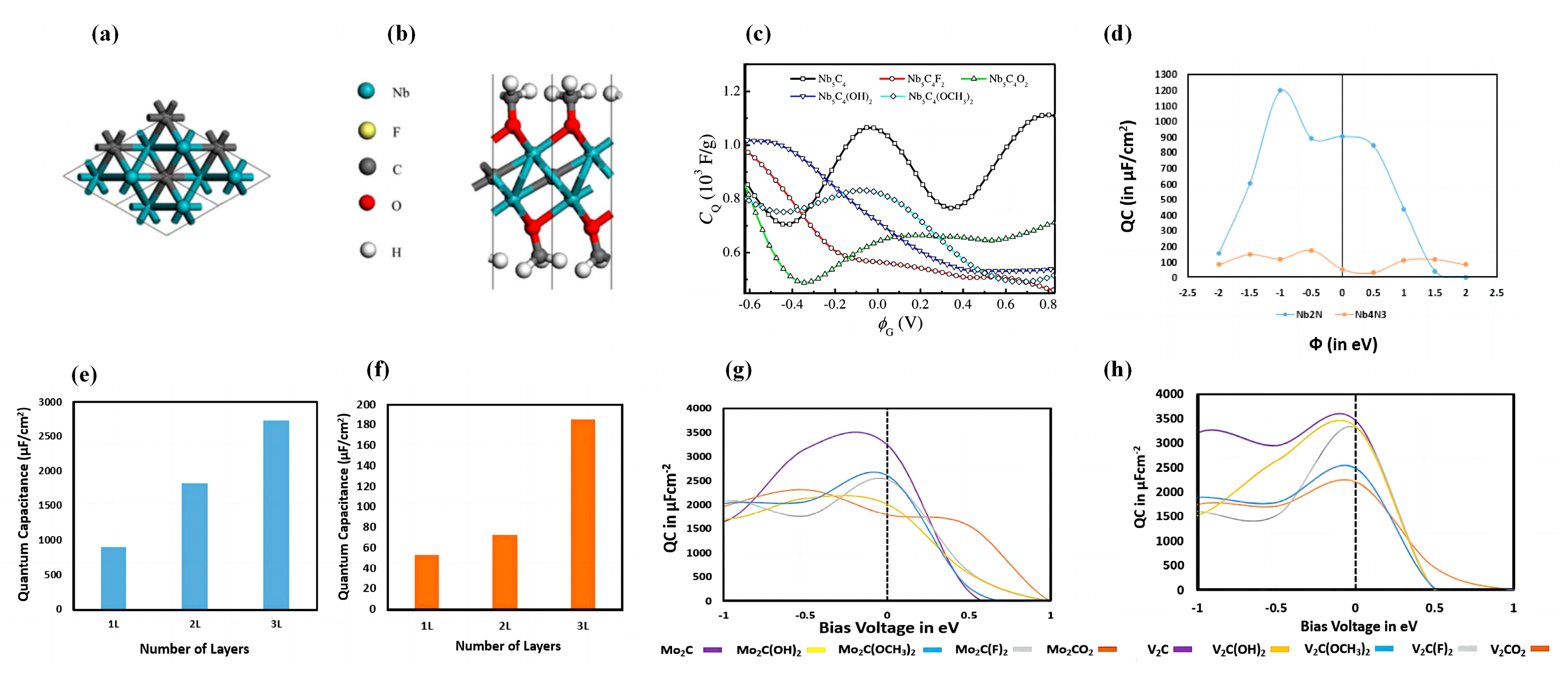
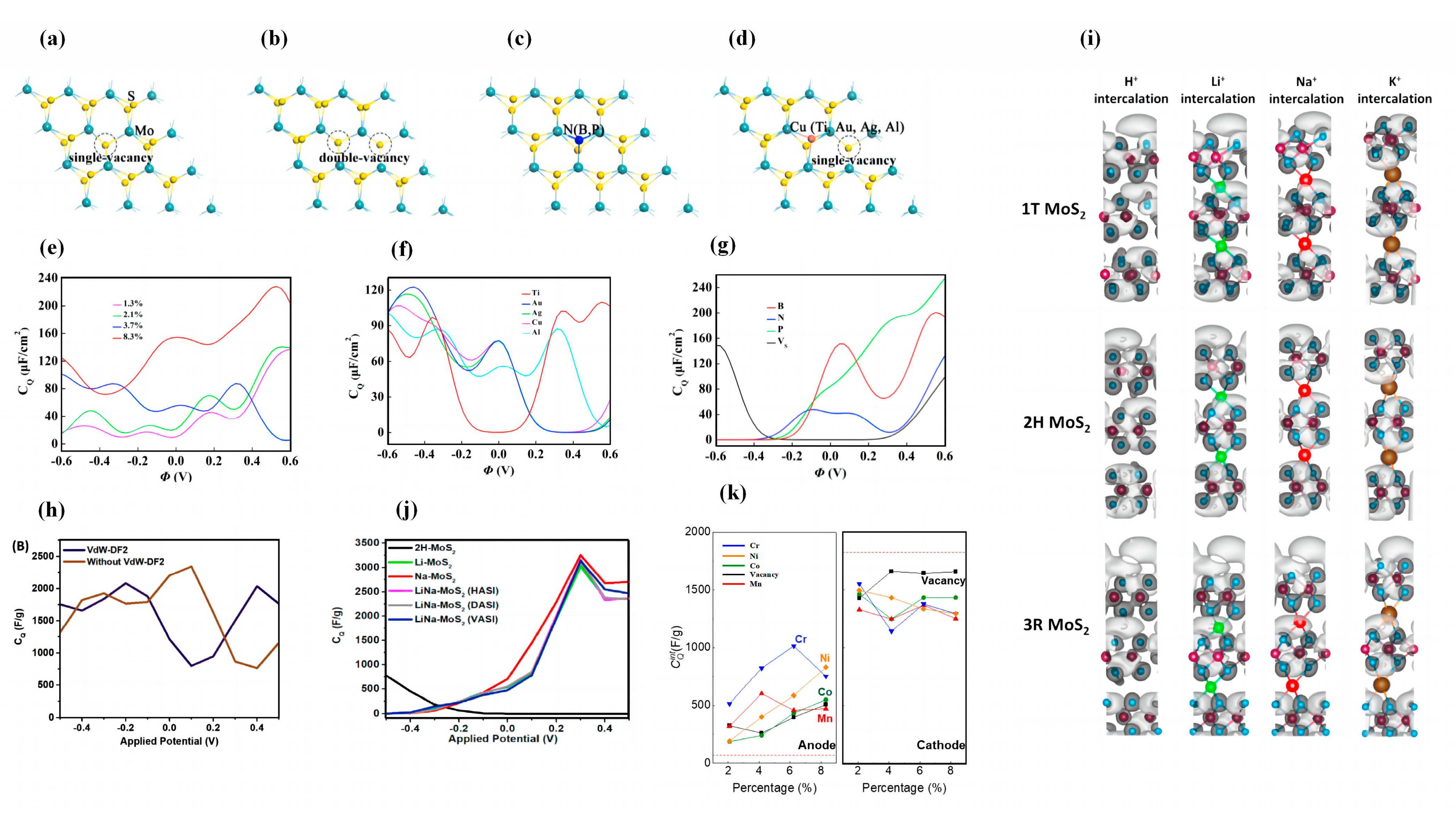
Disclaimer/Publisher’s Note: The statements, opinions and data contained in all publications are solely those of the individual author(s) and contributor(s) and not of MDPI and/or the editor(s). MDPI and/or the editor(s) disclaim responsibility for any injury to people or property resulting from any ideas, methods, instructions or products referred to in the content. |
© 2023 by the authors. Licensee MDPI, Basel, Switzerland. This article is an open access article distributed under the terms and conditions of the Creative Commons Attribution (CC BY) license (https://creativecommons.org/licenses/by/4.0/).
Share and Cite
Lin, J.; Yuan, Y.; Wang, M.; Yang, X.; Yang, G. Theoretical Studies on the Quantum Capacitance of Two-Dimensional Electrode Materials for Supercapacitors. Nanomaterials 2023, 13, 1932. https://doi.org/10.3390/nano13131932
Lin J, Yuan Y, Wang M, Yang X, Yang G. Theoretical Studies on the Quantum Capacitance of Two-Dimensional Electrode Materials for Supercapacitors. Nanomaterials. 2023; 13(13):1932. https://doi.org/10.3390/nano13131932
Chicago/Turabian StyleLin, Jianyan, Yuan Yuan, Min Wang, Xinlin Yang, and Guangmin Yang. 2023. "Theoretical Studies on the Quantum Capacitance of Two-Dimensional Electrode Materials for Supercapacitors" Nanomaterials 13, no. 13: 1932. https://doi.org/10.3390/nano13131932
APA StyleLin, J., Yuan, Y., Wang, M., Yang, X., & Yang, G. (2023). Theoretical Studies on the Quantum Capacitance of Two-Dimensional Electrode Materials for Supercapacitors. Nanomaterials, 13(13), 1932. https://doi.org/10.3390/nano13131932




